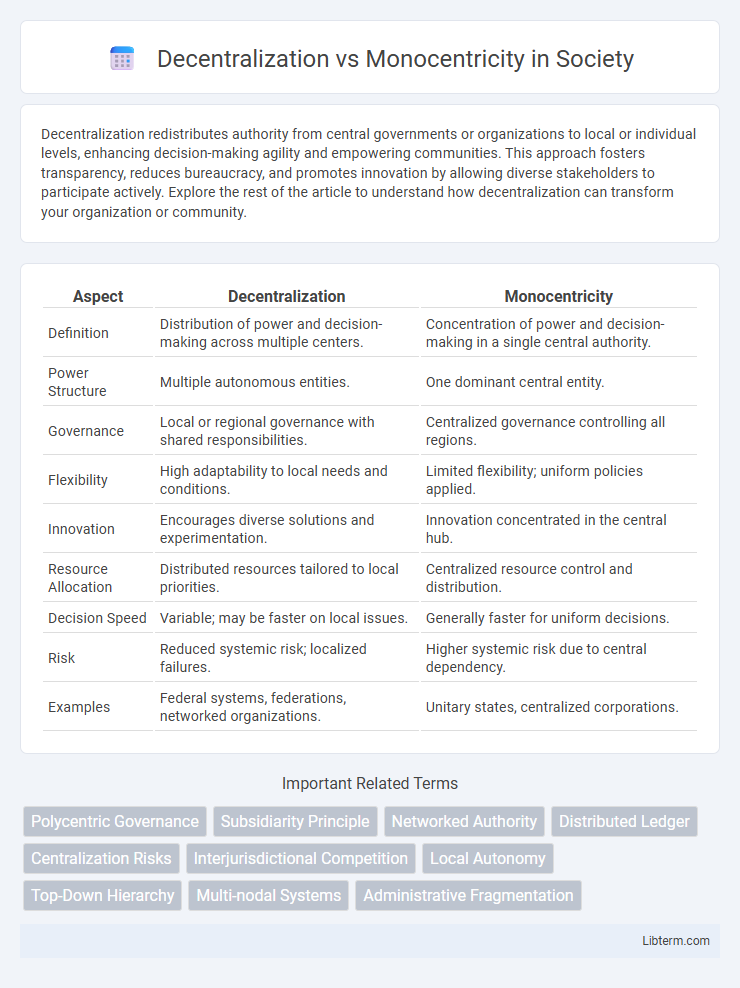Decentralization redistributes authority from central governments or organizations to local or individual levels, enhancing decision-making agility and empowering communities. This approach fosters transparency, reduces bureaucracy, and promotes innovation by allowing diverse stakeholders to participate actively. Explore the rest of the article to understand how decentralization can transform your organization or community.
Table of Comparison
| Aspect | Decentralization | Monocentricity |
|---|---|---|
| Definition | Distribution of power and decision-making across multiple centers. | Concentration of power and decision-making in a single central authority. |
| Power Structure | Multiple autonomous entities. | One dominant central entity. |
| Governance | Local or regional governance with shared responsibilities. | Centralized governance controlling all regions. |
| Flexibility | High adaptability to local needs and conditions. | Limited flexibility; uniform policies applied. |
| Innovation | Encourages diverse solutions and experimentation. | Innovation concentrated in the central hub. |
| Resource Allocation | Distributed resources tailored to local priorities. | Centralized resource control and distribution. |
| Decision Speed | Variable; may be faster on local issues. | Generally faster for uniform decisions. |
| Risk | Reduced systemic risk; localized failures. | Higher systemic risk due to central dependency. |
| Examples | Federal systems, federations, networked organizations. | Unitary states, centralized corporations. |
Introduction to Decentralization and Monocentricity
Decentralization involves distributing decision-making authority and resources across multiple local entities, enhancing flexibility and responsiveness in governance and organizational structures. Monocentricity, by contrast, centralizes power and control within a single central authority or location, often leading to standardized policies and streamlined enforcement. Understanding the balance between decentralization and monocentricity is crucial for optimizing administrative efficiency and regional development strategies.
Core Principles of Decentralized Systems
Decentralized systems prioritize distributed control, enabling multiple independent nodes to process and verify transactions without relying on a single central authority. This core principle enhances security, transparency, and fault tolerance by reducing single points of failure and promoting redundancy across the network. In contrast, monocentric systems concentrate decision-making power in a central entity, which can create vulnerabilities and limit scalability.
Key Characteristics of Monocentric Structures
Monocentric structures are characterized by a dominant central authority that controls decision-making processes and resource allocation within a single core area. These structures typically exhibit high levels of urban concentration, with economic, political, and infrastructural activities centralized in one primary city or region. The spatial organization promotes efficiency in governance but often leads to regional disparities and limited local autonomy.
Historical Evolution of Power Distribution
The historical evolution of power distribution reveals a gradual shift from monocentricity, where political and administrative authority was concentrated in a single center, to decentralization, which disperses governance across multiple local or regional entities. Early civilizations, such as ancient Egypt and Mesopotamia, exhibited strong centralized power relying on a monarch or a ruling elite, while medieval Europe demonstrated initial decentralization through feudalism and autonomous city-states. Modern state structures increasingly favor decentralization to enhance administrative efficiency, local participation, and adaptability, reflecting an ongoing rebalancing of power in governance systems.
Advantages of Decentralization
Decentralization enhances organizational agility by distributing decision-making authority closer to operational levels, enabling faster and more context-sensitive responses. It fosters innovation and accountability through empowered teams, promoting diverse perspectives and local problem-solving. Moreover, decentralization reduces bottlenecks in communication and enhances scalability by avoiding over-reliance on a single central point of control.
Drawbacks of Monocentricity
Monocentricity concentrates economic activities and population in a single urban core, leading to severe traffic congestion, higher pollution levels, and increased housing costs. This spatial imbalance exacerbates urban sprawl and strains infrastructure, reducing overall quality of life in peripheral areas. Limited access to opportunities and services outside the core hinders regional development and economic resilience.
Real-world Examples: Decentralized vs Monocentric Models
Decentralization is exemplified by countries like the United States, where governance and administrative powers are distributed across federal, state, and local levels, enhancing local decision-making and responsiveness. In contrast, monocentric models such as Paris, France, demonstrate centralized urban planning concentrated around a single core city, leading to intensified economic activity and infrastructure investment within one dominant metropolitan area. These contrasting approaches impact resource allocation, governance efficiency, and regional development outcomes significantly.
Impact on Innovation and Resilience
Decentralization fosters innovation by enabling diverse decision-making centers, promoting experimentation, and increasing adaptability across various nodes. Monocentric systems concentrate resources and authority, which can streamline processes but often limit creative problem-solving and reduce systemic resilience due to single points of failure. Empirical studies show decentralized networks enhance resilience by distributing risks and facilitating rapid recovery, critical for sustaining innovation under dynamic conditions.
Challenges in Transitioning Between Models
Transitioning from monocentric to decentralized urban models faces challenges such as infrastructure adaptation costs, governance complexity, and balancing equitable resource distribution. Monocentric systems centralize services and economic activities, whereas decentralization demands robust connectivity and coordination among multiple centers. Urban planners must address issues like zoning conflicts, investment disparities, and public resistance to shifts in spatial organization.
Future Trends in Organizational and Urban Structures
Future trends in organizational and urban structures indicate a shift towards decentralization, driven by advancements in digital connectivity and remote work technologies that enable distributed decision-making and resource allocation. Monocentric urban models are increasingly challenged by polycentric developments, where multiple hubs within a metropolitan area promote economic resilience and reduce congestion. Emerging smart city frameworks integrate decentralized data systems and participatory governance, enhancing adaptability and efficiency in complex socio-economic environments.
Decentralization Infographic

 libterm.com
libterm.com